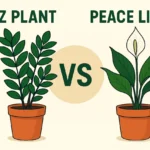Alocasia zebrina: A Striking Houseplant with Exotic Appeal
Alocasia zebrina is an eye-catching tropical plant that has become a favorite among indoor plant enthusiasts due to its dramatic arrow-shaped leaves and stunningly patterned “zebra-striped” petioles. Its unique architecture makes it a standout centerpiece in interiors, but growing it successfully requires some understanding of its native environment and specific needs.
In this article, we’ll walk you through everything beginner gardeners and plant lovers need to know to successfully care for Alocasia zebrina indoors, including lighting in measurable lux levels, watering, temperature, common problems, and more.
Botanical Background
Botanical Name and Family
Botanical Name: Alocasia zebrina
Family: Araceae (the Arum family)
Origin and Native Habitat
Alocasia zebrina is native to the rainforests of the Philippines. It thrives in warm, humid, dappled environments under the tropical canopy, where it receives filtered sunlight and regular rainfall.
Wild Species or Hybrid
This is a naturally occurring wild species, not a hybrid. Its distinctive striped petioles are not the result of breeding but a natural adaptation that likely plays a role in camouflage and structural support in its native habitat.
History of Cultivation
Alocasia zebrina was introduced internationally in the mid-20th century during the houseplant boom. Its unique coloration and bold form quickly gained popularity among collectors and interior designers. Due to its increasing demand, it is now cultivated in greenhouses globally.
Lighting Requirements in Lux: Getting It Just Right
Lighting is one of the most important aspects of caring for Alocasia zebrina. This tropical species does best with bright, indirect light.
- Optimal Growth Range: 10,000–20,000 lux. This mimics filtered sunlight under a rainforest canopy.
- Acceptable Borderline: 6,000–10,000 lux. Growth may be slower, but the plant can remain healthy.
- Minimum Survival Threshold: 3,000–5,000 lux. The plant may survive but become leggy and prone to yellowing.
- Too Much Light: >25,000 lux (e.g., direct afternoon sun). This can scorch the leaves, particularly through windows without sheer curtains.
Grow Lights: If you don’t have a bright window, a full-spectrum LED grow light (2,500–4,000 lumens at 30 cm distance) running 10–12 hours a day can keep your Alocasia zebrina thriving indoors, especially during winter months.
Watering Needs by Season and Conditions
Alocasia zebrina is sensitive to both overwatering and underwatering, and its watering frequency should be adjusted based on pot size, season, and ambient humidity.
Watering Guidelines
- Spring and Summer: Water when the top 3–5 cm of soil feels dry. For a 15–20 cm diameter pot, this generally means every 5–7 days in 50–60% ambient humidity.
- Autumn and Winter: Reduce watering to every 10–14 days. Ensure the plant does not sit in water, as roots are prone to rot when inactive.
- Larger Pots: May require less frequent watering due to greater soil volume retaining moisture longer.
- Humidity-Adjusted Tip: In high humidity (above 70%), reduce watering frequency as the plant transpires less.
Always check your soil moisture before watering. Using a chopstick or moisture meter can help ensure you’re watering at the right time.
Temperature and Humidity: Create a Tropical Microclimate
Temperature Range
- Ideal Daytime Temperature: 21–28°C (70–82°F)
- Night Temperature: Not lower than 16°C (60°F)
- Avoid: Drafts, heaters, or cold windowsills in winter, which stress the plant and may trigger dormancy
Humidity Requirements
- Optimal Range: 60–80%
- Minimum Tolerable: 45% — below this, leaf edges may brown
- Recommended Tools: Use a digital hygrometer to monitor. Humidifiers or pebble trays near the plant can increase local humidity.
Common Problems and How to Solve Them
1. Yellowing Leaves
Cause: Usually overwatering or poor drainage.
Solution: Let soil dry more between waterings; ensure pot has adequate drainage holes and use well-aerated potting mix.
2. Leaf Curling or Drooping
Cause: Underwatering, cold drafts, or too little humidity.
Solution: Check moisture level and adjust watering; move plant away from drafts; increase room humidity.
3. Spider Mites or Aphids
Cause: Dry air often encourages pests.
Solution: Wipe leaves regularly, keep humidity up, and spray with neem oil solution weekly if pests are present.
4. Leaf Spotting or Holes
Cause: Fungal infection or physical damage.
Solution: Improve air circulation, avoid splashing water on leaves, and remove affected foliage with sterilized scissors.
5. Dormancy in Winter
Cause: Natural response to cooler temperature or shorter days.
Solution: Reduce watering, maintain humidity, and resume regular care in spring. Don’t panic if leaves drop—they often regrow.
Toxicity and Safety Notes
Alocasia zebrina, like other members of the Araceae family, is toxic to humans and pets if ingested, due to calcium oxalate crystals. These can cause mouth irritation, vomiting, and difficulty swallowing.
- Pets: Keep away from cats and dogs.
- Children: Avoid placing the plant within reach of young children.
- Handling: Wear gloves when repotting or pruning and wash hands afterward.
Real-Life Care Tricks and Pro Tips
- Use a clear plastic saucer under the pot: This helps you easily monitor runoff and avoid water lingering at the base.
- Rotate your plant weekly: This encourages symmetrical growth and prevents leaning toward the light source.
- Leaf support: The tall petioles can sometimes bend under their own weight; use thin plant stakes if needed.
- Refresh topsoil: Every 3–4 months, remove the top 2 cm of soil and replace with fresh potting mix to prevent salt build-up and renew nutrients.
- Humidity hack: Place the pot on a tray filled with pebbles and water—just make sure the pot bottom is above the waterline to avoid root rot.
- Seasonal growth awareness: Expect slower leaf production and increased yellowing in winter—this is part of its partial dormancy cycle.
Conclusion: The Rewarding Journey of Growing Alocasia zebrina
Despite its tropical origins and specific needs, Alocasia zebrina is an incredibly rewarding plant to grow for those willing to understand its care routine. By replicating its natural environment—with bright indirect light around 10,000–20,000 lux, consistent warmth, and adequate humidity—you can enjoy this architectural beauty indoors year-round.
Remember, like many tropical plants, Alocasia zebrina thrives on consistency. Monitor its environment, adjust with the seasons, and respond to warning signs early. With some patience and attention, even beginners can raise this exotic beauty into a striking indoor showpiece.
References
- Chadwick, C., & Swarthout, L. (2020). The Houseplant Handbook: Basic Growing Techniques and a Directory of 300 Everyday Houseplants. Firefly Books.
- Missouri Botanical Garden. (n.d.). Alocasia zebrina. Retrieved from https://www.missouribotanicalgarden.org
- Royal Horticultural Society. (2021). Alocasia care tips. Retrieved from https://www.rhs.org.uk








